-
Posts
304 -
Joined
-
Last visited
Content Type
Profiles
Forums
Gallery
Events
Posts posted by RossR
-
-
I have made some progress on the yards. The plans in the kit show the stirrups for the foot ropes being made out of an eyebolt that is wrapped with thread to give the appearance on it being rope. I didn’t care for the look of this.
from a limited amount of research, it seams the stirrups were usually nailed to the yard and then wrapped around it three times. Nailing a rope seams to be a strange way to attach a rope to anything, then I saw Archjofo‘s example on his French Corvette. The stirrups were braided first. The nail still seams an odd choice, but I can envision a nailed braided rope holding.
unfortunately, I tried and failed at braiding the thin ropes to creat the stirrups. I then tried a regular rope with a spliced loop for the foot rope. I couldn’t seam to get the spliced loop small enough, and it looked out of scale. I ended up using the technique that Chuck used in his Model Shipways US Brig Syren and made the stirrups out of black annealed wire.
I started adding the blocks using the technique I described in my bow sprite post less using served rope. This creates a very secure connection, but the block doesn’t always hang naturally. I came across the YouTube video and decided to give it a try.
Using this technique allows the blocks to hang more naturally, but I worry they won’t be as secure. That will only be a concern if I accidentally pull on a line too hard by accident.
here is the main royal yard with the blocks attached my old way and the main top gallant yard with the blocks attached the new way.
the top picture has the blocks attached the old way.
I am posting this from the airport, and will be traveling for work this week. I will hopefully get back to the model next week.
-
-
With the standing rigging complete except for the top gallant back stays, I have started making the yards. The yards on this kit are fairly simple. They all have a slight taper from the middle towards the end and then a step down to a diameter roughly half the diameter at the center about 1/4 to 1/2 inch from each end of the yard. I start by cutting a dowel about 1 inch longer than the finished yard, and marking the center, the point that the diameter steps down and then each end of the yard. I leave the extra inch of material on one end to put in the chuck of my drill for the tapering.
Since the taper from the middle is very slight 1mm - 0.5 mm depending on the starting diameter of the yard, I just use sandpaper to create the taper. After getting the taper right, I use a knife to cut a small slit at the point of the step on the far end of the yard from the end that is in the chuck of the drill and then with a small chisel or knife I cut away material to rough in the smaller diameter after the step.
The piece goes back into the drill and I use sandpaper to round the end.
I then use the knife and chisel to create the step at the other end leaving the extra material for the drill chuck alone. Then back in the drill and more work with the sandpaper to round the step near the drill chuck.
I then cut the extra material off and clean up the ends.
I will paint these brown after getting a code of shellac to seal them. I need to make a total of 12 yards. Then attach all of the blocks that will be needed.
-
1 hour ago, JacquesCousteau said:
Does the Syren rope need to be glued before it's cut? I know some ropes will unwind otherwise.
I have had a similar experience as Brunnels. No issue with it unwinding. I always cut it with a newer sharp blade. I keep a separate exacto knife for cutting the rope and only use it for that so it stays sharp.
- Chuck, brunnels and JacquesCousteau
-
 3
3
-
Seeing your progress makes me anxious to get started on my half hull that is sitting on the shelf. Great job.
- mtaylor, JacquesCousteau and Canute
-
 2
2
-
 1
1
-
I now have the top mast backstays added for all three masts. These are .018 rope. I served the section at the top that wraps around the mast.
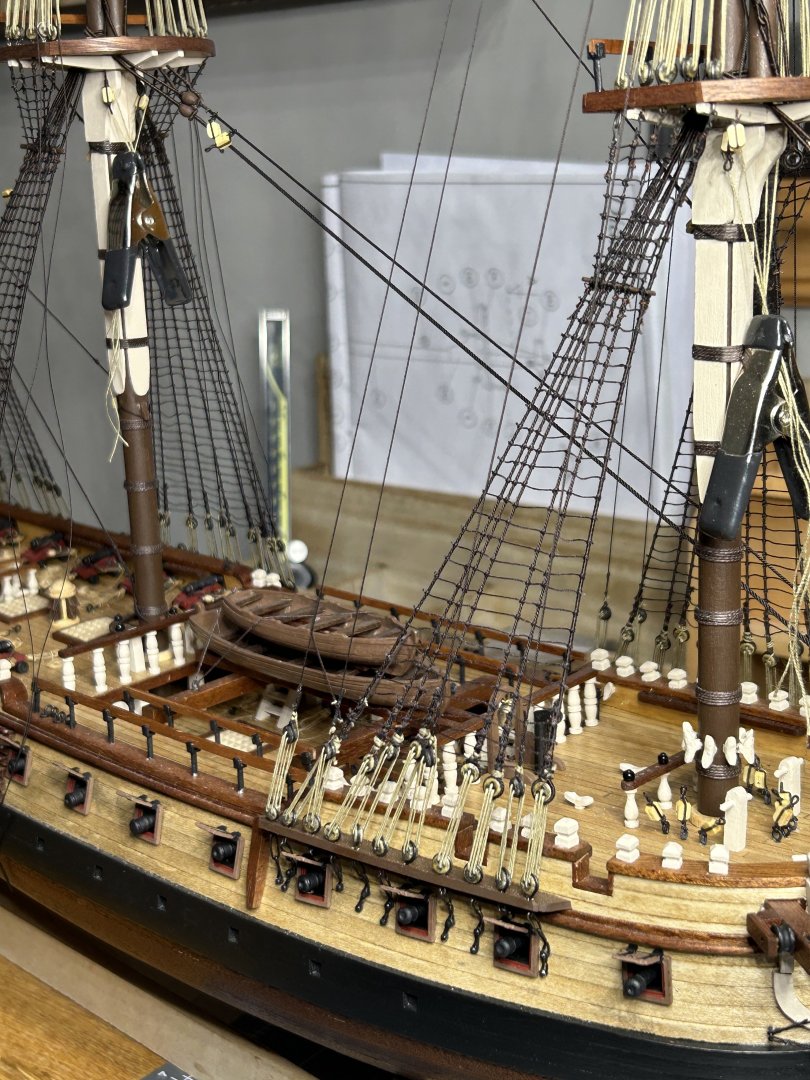
I added the top gallant backstay to the fore mast, but I am a little concerned that it will make accessing the pin rails for the running rigging difficult. For the main and mizzen masts I will plan on waiting to attach the lanyard until after the running rigging is in place. If I need to I can remove the lanyards on the top gallant backstays for the fore mast and re-attach later if it helps adding the running rigging.
see below fore my concern on the access to the pin rails.
-
Can’t wait to see your build log for Sherbourne.
- Isaiah and Ferrus Manus
-
 1
1
-
 1
1
-
Did you drill the hole for the bowsprit. You will need to drill through the planking. I attached a couple pics from the instruction where you can see the hole. Not great pics of this in the instructions. If I remember, there is a gap between two filler pieces on either side of the bulkhead former that you will drill into.
- allanyed, JFMJr and Scottish Guy
-
 3
3
-
59 minutes ago, DaveBaxt said:
I have used it quite a few times already and is very handy for exactly this sort of job. Hope this helps
Thanks. I have been running lines through the blocks or spliced eye and you have to create tension by winding up the secondary lines. Your solution eliminates that.
-
Good luck with the copper plates. Can’t wait to see it when you are done.
-
I would love it if you shared some details on how you rigged the Servomatic with the alligator clips. Are you able to adjust the distance between them?
-
I really appreciate that we, as users of this web site are not monetized the way most for profit (and even some not for profit) website would do. Since Model Ship World is sponsored by the NRG, keeping these organizations financially secure is important to me. That is one of my primary reasons I for joined the NRG. The magazine does have features on 20th century subjects, but I will let others chime in regarding yachts specifically. The magazine is very well done and the print version is of a quality you don’t see very often these days in our digital world. Sometimes it is still nice to read something that isn’t on a screen.
- mtaylor, ferretmary1, tlevine and 5 others
-
 8
8
-
I have continued my work on the stays and made quite a bit of progress. After posting my method for making the mouse, I have to admit that I am surprised that nobody asked why I used square stock instead of a round dowel to make the mouse? I have no idea why I used square stock. I keep all my little scraps of wood and I guess I grabbed the first thing I saw that would work. I did switch to using a round dowel when it occurred to me that I was making a little more work for myself.
As I started making the stays higher up the masts and the lines got smaller, I struggled with splicing the line to create the loop. At .018 inch diameter line, I really struggled. After trying and failing a few times I started to get the hang of it and in the end I am really happy with the result of the splices I used to create the eyes on the stays.
I also have completed the bowsprit by adding the dolphin stryker.
With all of the stays now done, the next step will be adding the backstays and starting to build the yards, boom and gaph.
Thanks for all the views and likes.
- KurtH, CiscoH, Thukydides and 1 other
-
 4
4
-
I have made some progress on the stays. I have to thank Thukydides for sharing his techniques. Both for the mouse and for splicing the lines to create the loop. I started with the fore stay and main stay. Both of these are made from .044 inch line. This line has four strands and being a little thicker made the splicing a little easier than I experienced with some of my earlier attempts.
I start by serving about 1/2 inch of the line. It is hard to see the serving in the photo, but it is the section between the arrows. I then cut the line about an inch from the end of the serving and separate the strands on that section.
I then create a small loop and start to pass the four strands through the line below the loop. I try to pass each strand through the line 2 -4 times staggering how far down the line each strand goes. I hope to get a smooth taper after the line is served below the loop.
I am creating a false splice and it will not hold under tension on its own. I tie a loop of thin thread around the splice below the loop to secure it.
I then serve the line from the loop down to just below the spot that the mouse will go. I add some diluted varnish to help hold the bend in the loop.
Next is fabricating the mouse. I start with a 4mm x 4mm peice of wood. I drill a small hole just big enough for the served line to fit through with as snug of a fit as possible. I used a 1.2 mm drill bit for the .044 line and a 1mm bit for the .030 line.
After using a knife to create a very rough shape, I put the wood into a drill and use sand paper and a file to round the mouse and refined the shape.
After sliding the mouse on the line I add a few half hitches with a thread above the mouse to be sure it doesn't slide up the the line by accident.
Thukydides then coated his mouse with a thin fabric to give it a more realistic texture. Since I have trouble seeing the serving at this scale sometimes, I decided to just paint the mouse.
I have fore stay, main stay, fore preventer stay and main preventer stay added. I am a little confused as to which is the preventer stay. I am assuming the preventer stay is the one on top. I have that wrong I apologize. The main and fore stay are made from .044 inch line and the preventer stays are from .030 line.
I do not think that my results are as good as Thukydides and I would encourage you to check out posts 334 and 434 from his HM Cutter Alert build log. I will be adding the other stays over the next week or two.
I also added the gun port hatches. The kit supplied metal frames and hatches. I briefly considered trying to build my own, but I choose to move forward with the kit supplied items. I did choose to paint them. The small size and detail needed pushed my eyesight to its limit. I ended up using a 3x magnifier on my work light.
After getting through the ratlines I am really enjoying the rigging process again. Looking forward to starting on the yards.
-
I have the bowsprit done less the dolphin stryker. I will hold off attaching that as long as possible. I am convinced I will break it off while working on another part of the ship.
If anyone is interested, I thought I would share how I seize a block. There are others, such as Johan on his French Corvette, that produce unbelievable results, but I am not able to duplicate his results with my skill and maybe partially due to the scale I am building at. Here is how I am seizing the blocks.
I sometimes use a helping hand device, but usually I just use self closing tweezers. I create a small loop in the line. for purposes of scale the grid on this cutting mat has 1 cm squares. In this case line is .018 mm line from Syren.
I then make three loops with loops of thread and tuck one end through the loops. I am Mara thread from Gutterman. It is the 120 size, but I can't explain what those numbers mean. The sizing on thread is a mystery to me.
The loop is placed of over the line that is being held in the tweezers and tightened on the line.
I will add a couple of overhand knots alternating the sides on the overhand knots to ensure the knot stays tight. I will slide the knot up a little to create an opening just big enough to accommodate the block the place the block in the loop and then use a pair of tweezers to slide the knot up tight against the block. A few more alternating overhand knots to ensure tightness.
Then remove the line from the self closing tweezers and create a second loop.
I add a couple more overhand knots to create the loop that will go over the spar or yard or what ever you are attaching the block too. Remove the block from the tweezer and place in the item you are seizing it too. Pull both ends of the line tight and add a couple more alternating overhand knots to secure the block.
Trim off the excess line and use some diluted varnish or diluted PVA to secure the knot. Use as few overhand knots as you can and still secure it tightly to avoid looking too clunky.
Not sure if this is the best way to secure a block, but it works for me and I thought I would share it.
-
1 hour ago, Chuck said:
I believe I recieved a $500 gift certificate for Model Expo products for that design. I think they got a good deal on it, LOL.
Wow. I would say they got a great deal.
- thibaultron, Canute and mtaylor
-
 3
3
-
-
I finally finished the mizzen mast. The assembly was simply a smaller version of the main mast without the cheeks and wooldings. I enjoy the rigging process, but I am glad to move on from shrouds and ratlines for a while. For a while I was keeping track of the number of clove hitches I tied, but I stopped at about 1800.
I have also started adding the gun port hatches. I will post about them in a later post.
Next up will be the bowsprit and the stays. The bowsprit is already built. I posted about that earlier. The stays will be installed using a mouse. this will be a first to me and I am looking forward to that.
- Mr Whippy, CiscoH, Thukydides and 4 others
-
 7
7
-
-
On 3/19/2024 at 6:58 PM, Tossedman said:
what blades do Ultimation recommend?
Here is what Ultimation provides regarding the replacement blades. The blade on the right is the blade for the Ultimation. The one on the left is a regular utility knife blade. The utility blade is a little bigger and has two notches instead of one on the top.
-
This was my first model also. I had not discovered this site yet when I did my planking. I used the instructions and the Occre YouTube videos to instruct me.
This is not the historically accurate way to plank a hull. If planking it in a historically accurate manor is important to you, there are many resources on the site and YouTube. Look at TLevine’s half hull project on the sight and Chuck Passaro’s YouTube videos. I will caution you that I am not convinced the very thin second layer material from Occre is suited to Chuck’s technique.
My goal on that model was just to build Occre’s version of the HMS Beagle. I enjoyed myself enough to build a second ship and now I have a couple more on the shelf. My future ships will be planked using more accurate techniques. But I think I would have failed if I had attempted it on my first model.
My advice is to decide what is important to you on this build, look at the material available on the site and from Occre and decide how you want to proceed based on that research.
Good luck.
-
They are definitely the carpet blades with a bevel only on one side. Ultimation resells them, but also provides information so you can source them elsewhere.
- mtaylor, Ryland Craze and Tossedman
-
 3
3
-
On 3/3/2024 at 7:51 AM, bigcreekdad said:
I threw my chopper away years ago. Couldn't get a straight vertical cut out of it. Wish there was something else to get perfectly straight vertical cuts.
I am a little late with this info, but I think bigcreekdad’s issue of straight vertical cuts may be solved with a single bevel blade. See my review of the Ultimation Slicer. It isn’t inexpensive, so some modelers will stay away. If you can justify the price it is very well made.
I have seen YouTube videos of people using it on material that looks to be about 4 mm thick, but I don’t think go any bigger though.
Aon’s solution works also.
-
It has been a month since my last post. Work has kept me busy so progress has been a little slow. I finally finished all of the shrouds and ratlines on the main mast. The main shrouds are .030 inch diameter ropes and the rest of the shrouds are .018 inch diameter ropes. The ratlines are .008 inch diameter rope. All of the dark ropes are from Syren. For the lanyards I used the natural lines provided by Occre.
I find the futtock stave at the top of the top mast shrouds to be particularly challenging to work with. The space between the shrouds is so small that I really struggle manipulating the lines to lash the stave to the shroud and then to lash to futtock shrouds to the top mast shrouds after they wrap around the stave is equally difficult. The close up photography is not very forgiving, but from 12 - 24 inches away with the naked eye I am pretty happy with the results.
Next up will be the mizzen mast, then on to the backstays and stays.

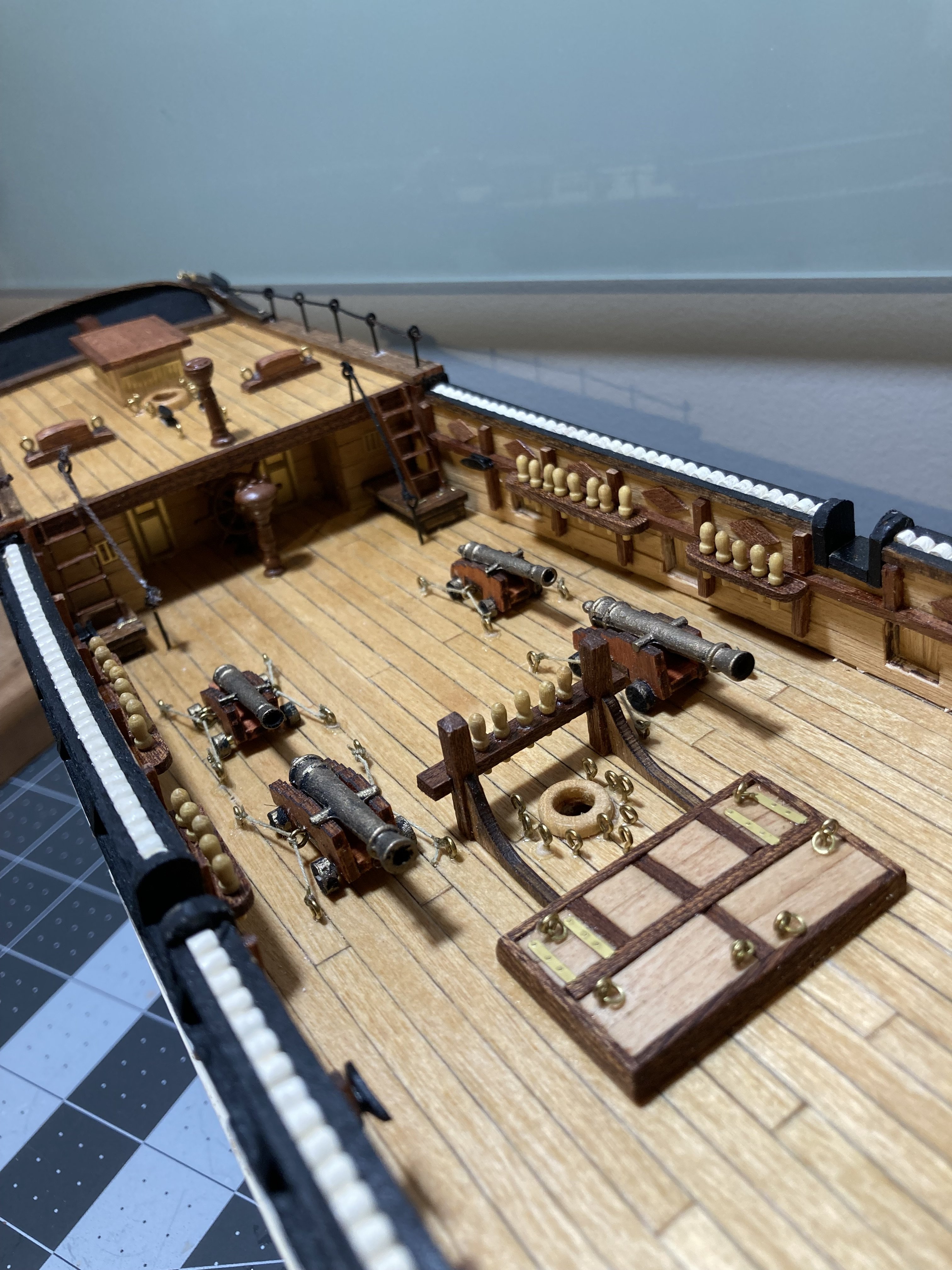
.thumb.jpeg.ffac2f8a24d212961a83eab4efb06a6c.jpeg)
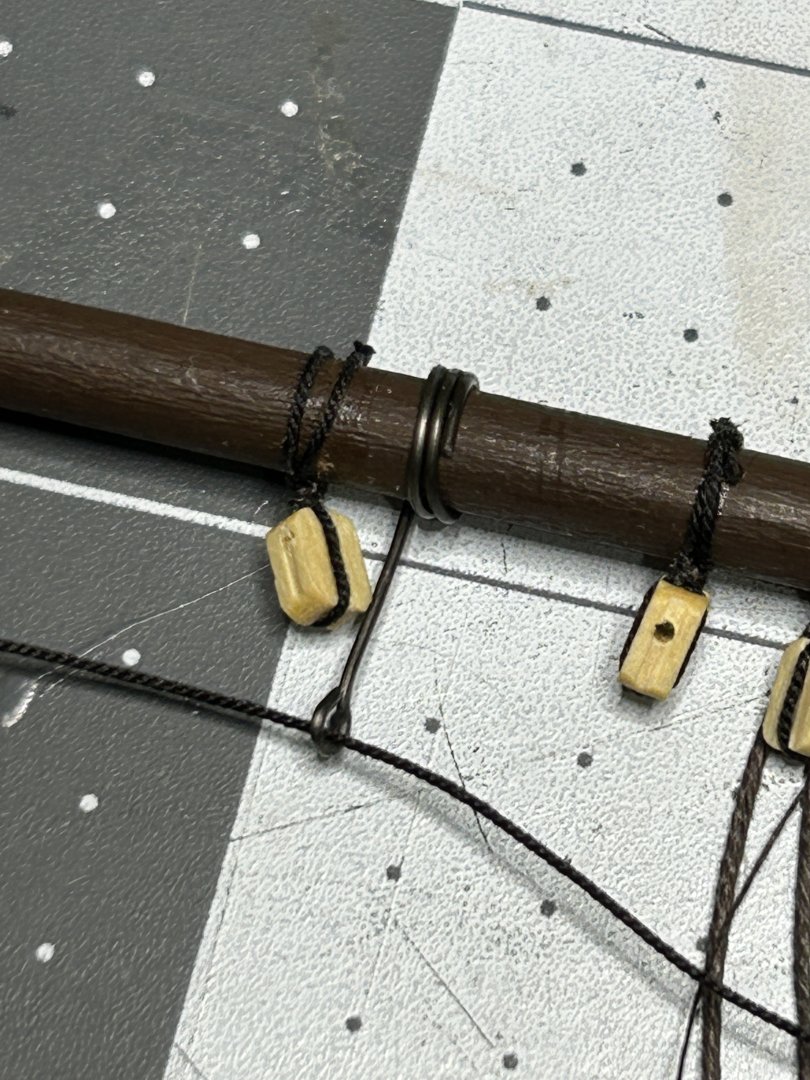
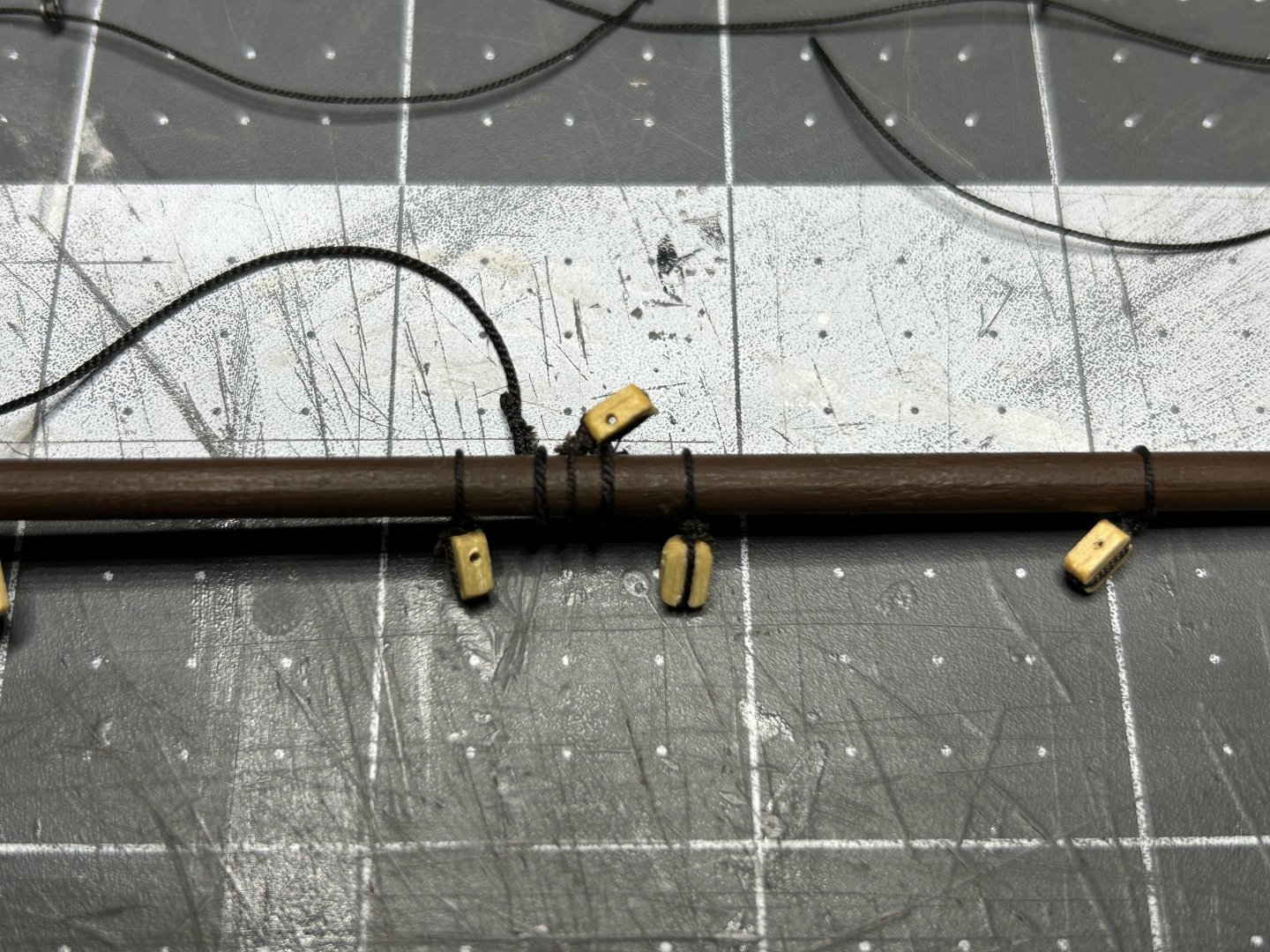
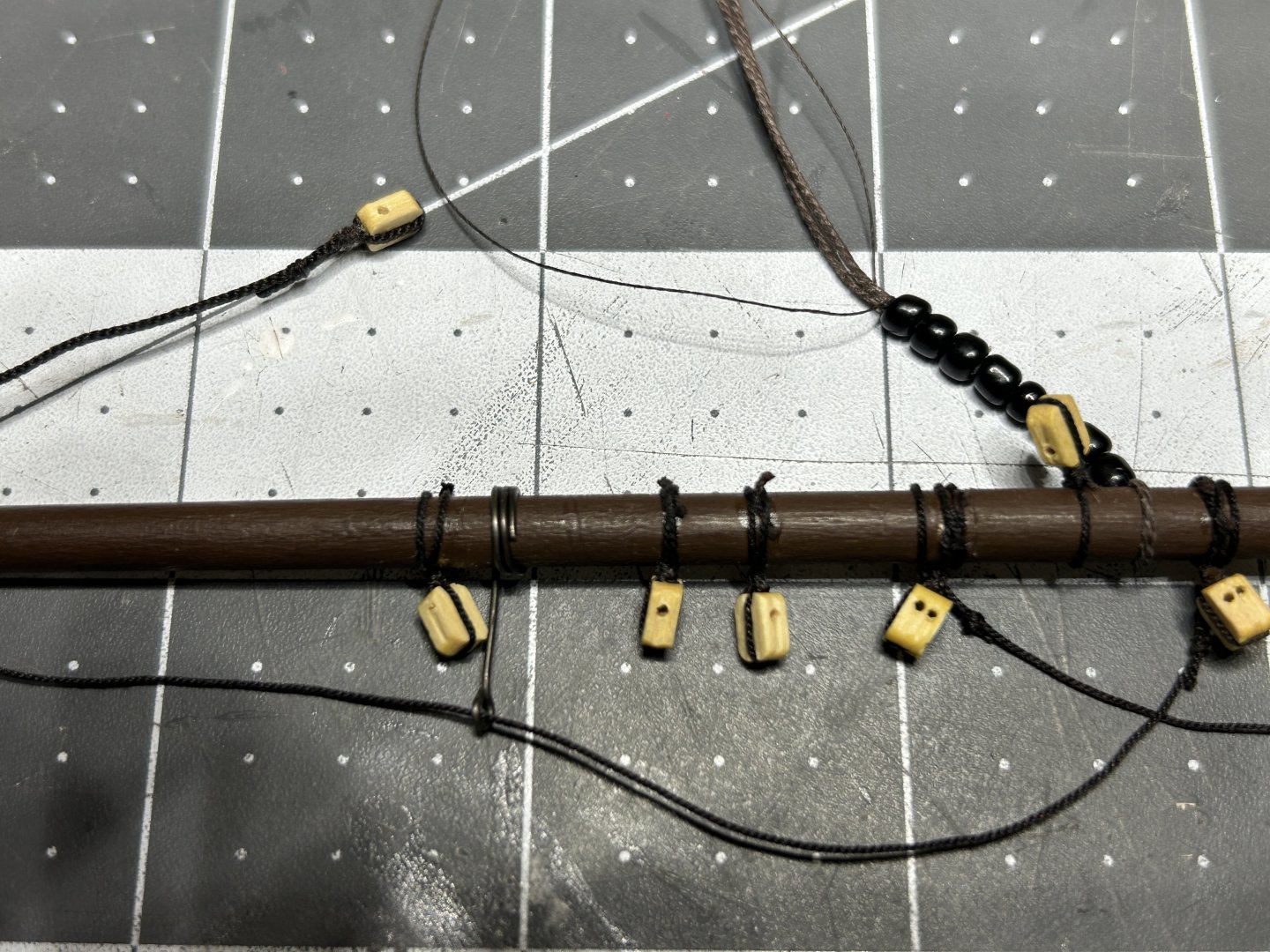
.thumb.jpg.f95c006863804280ca47d7738e80dce2.jpg)
.thumb.jpg.0a9387879c50a8d27966f09b234ed663.jpg)
.thumb.jpg.d32cfab2a7b79f56861b823985eb26e6.jpg)
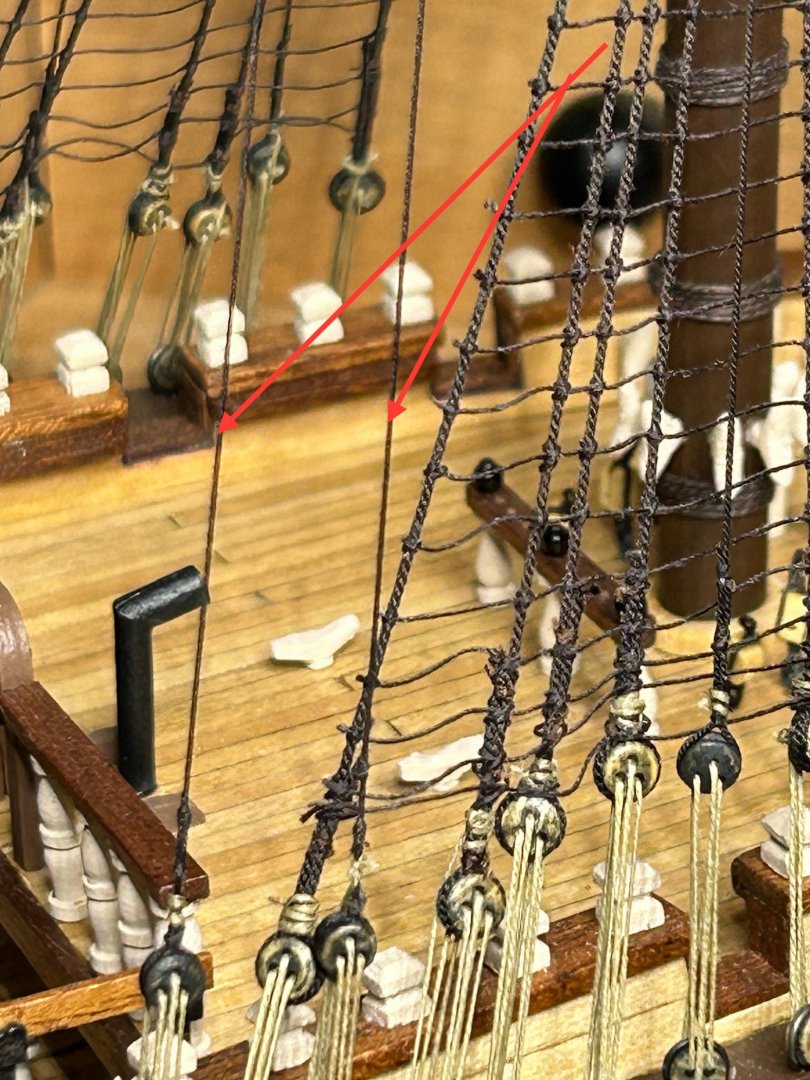
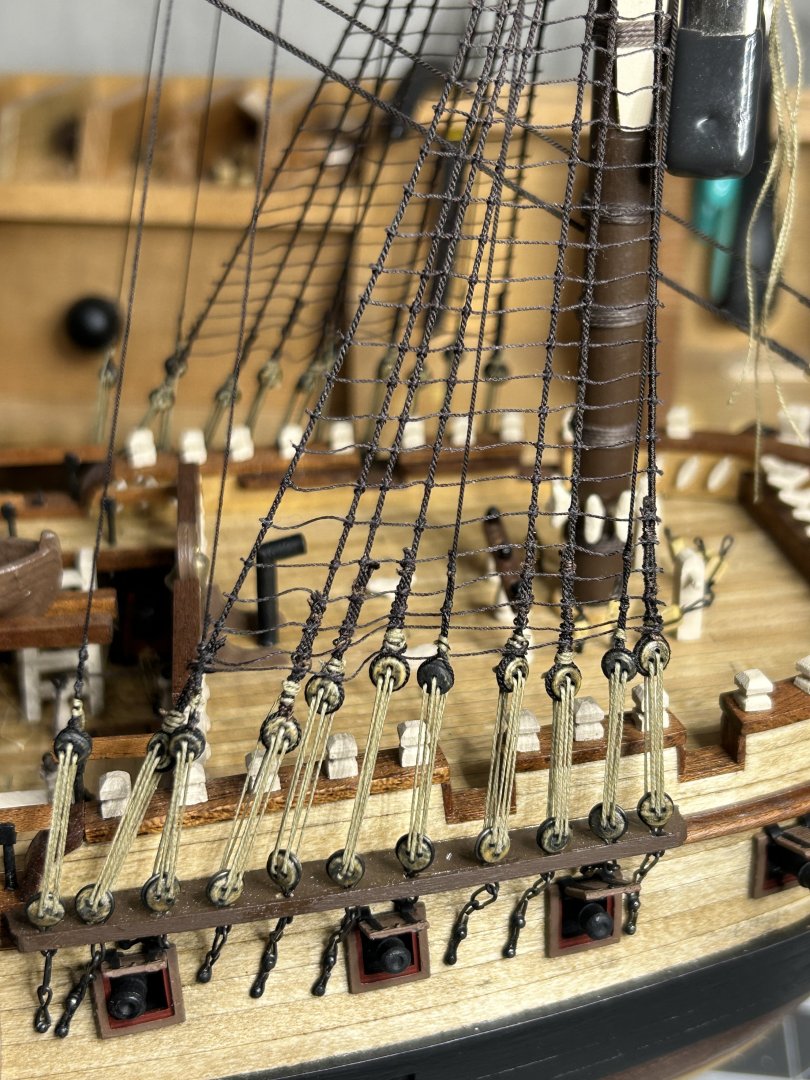
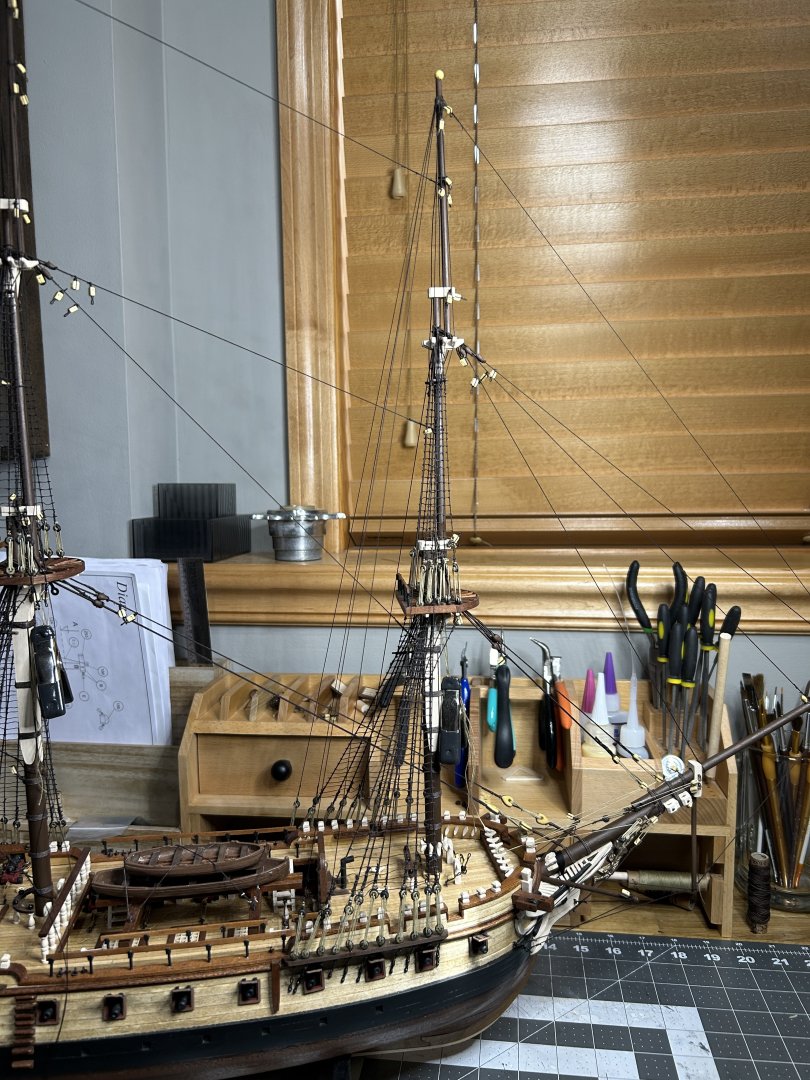


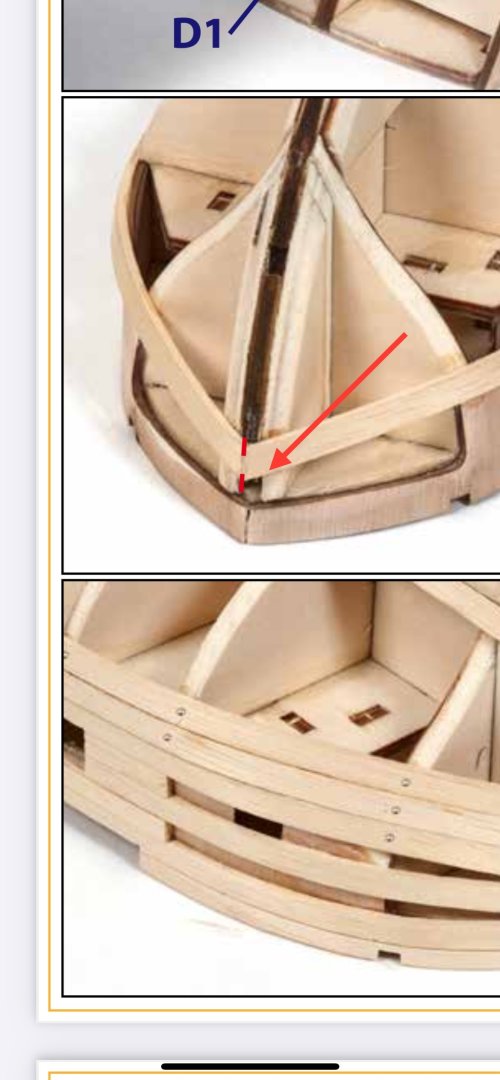
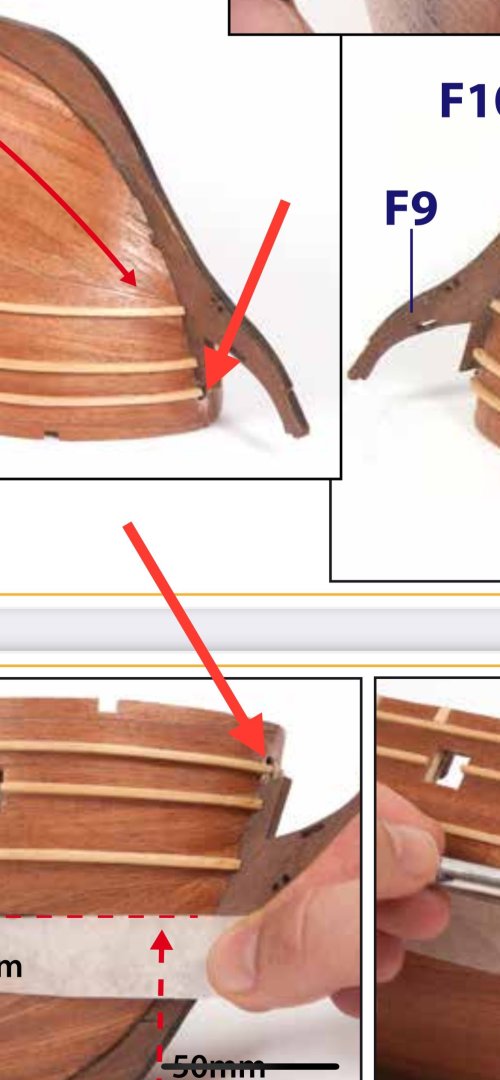
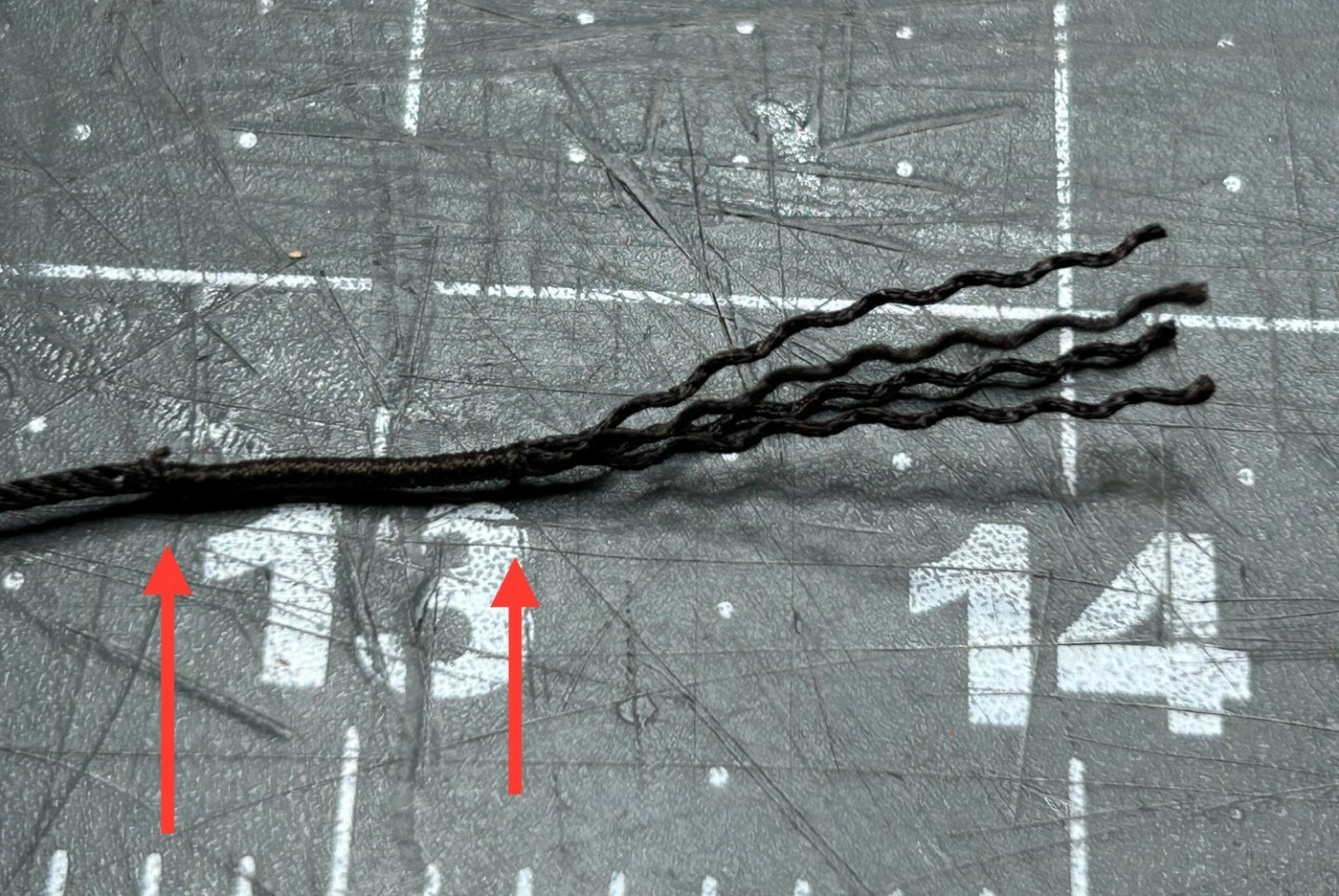
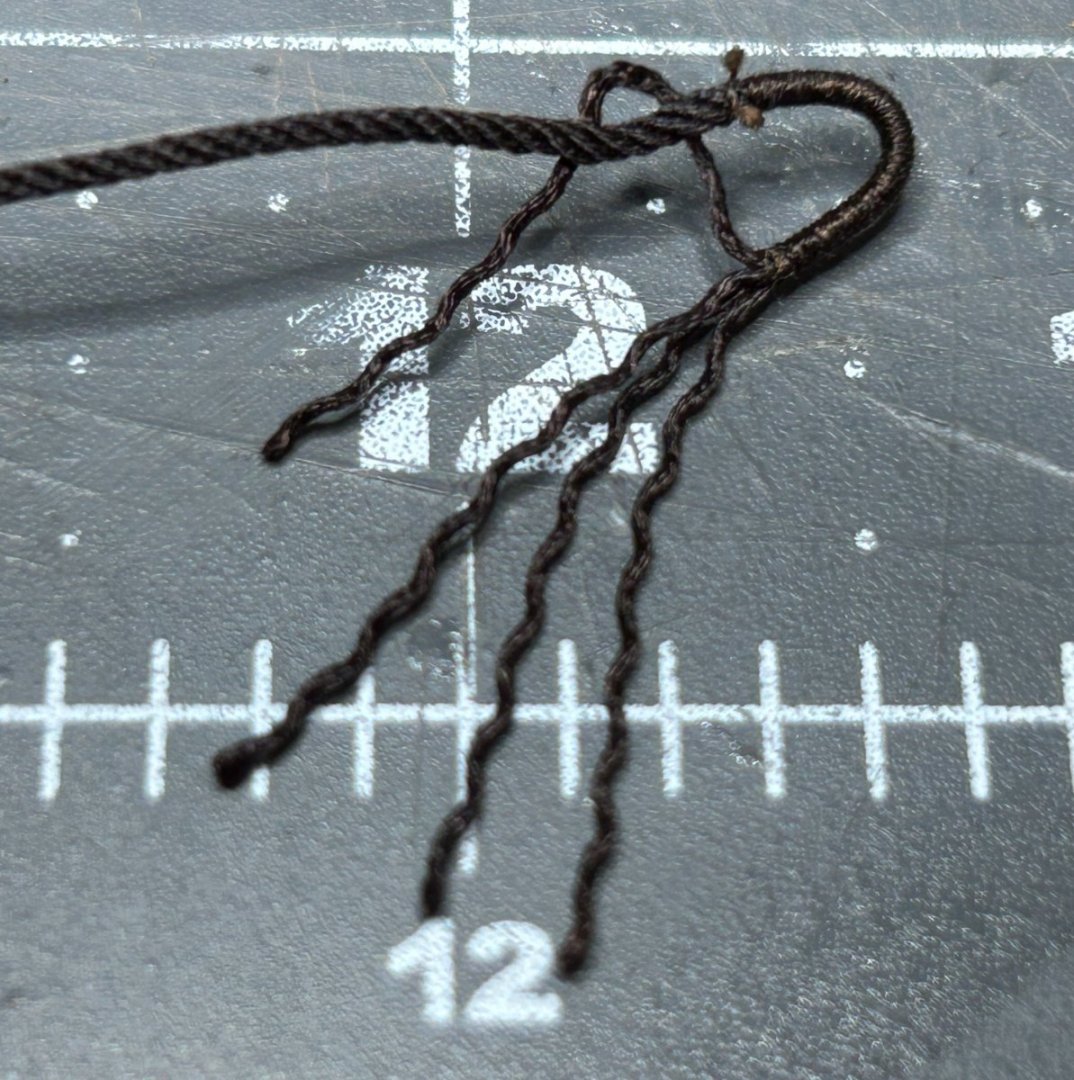
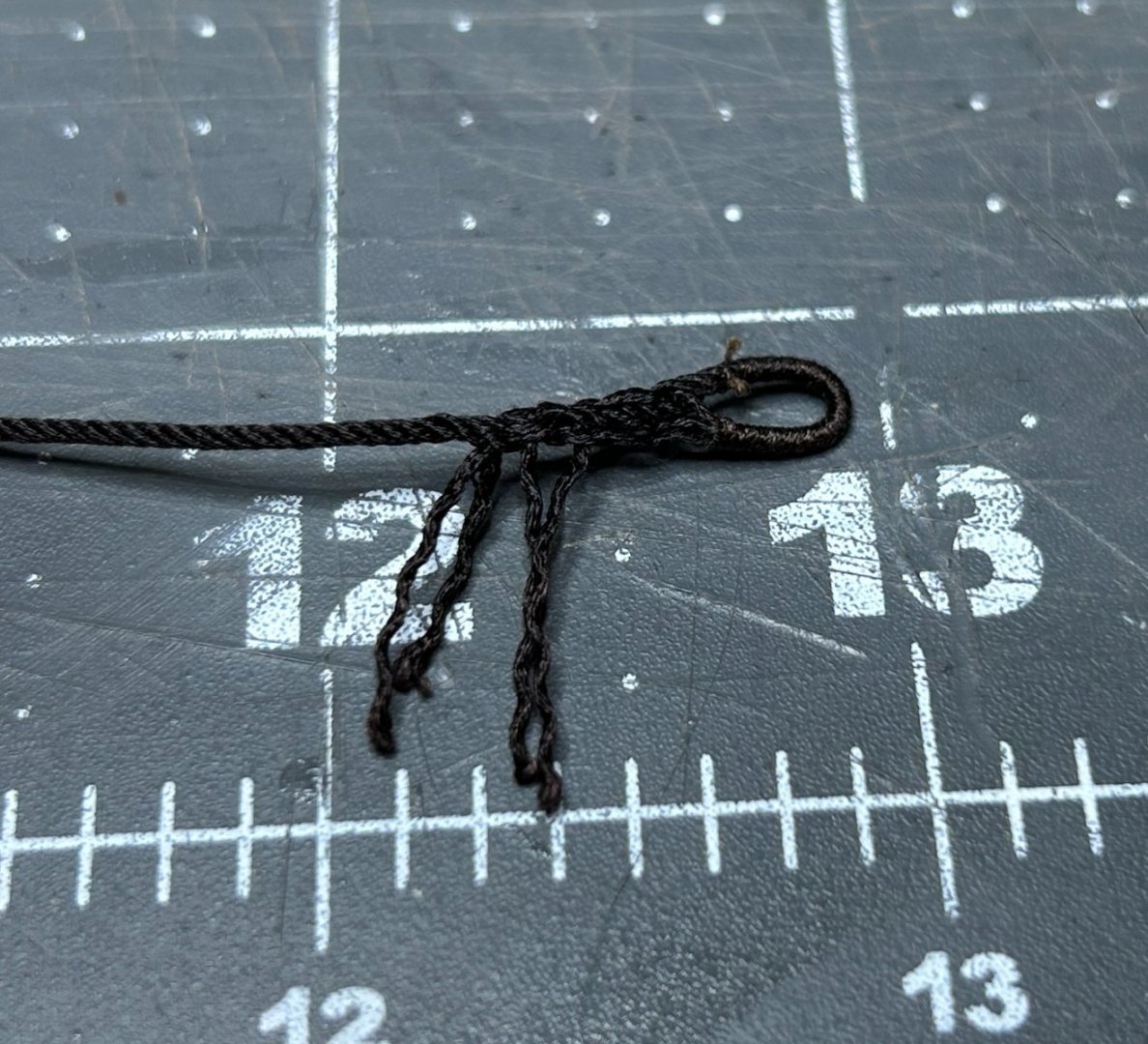
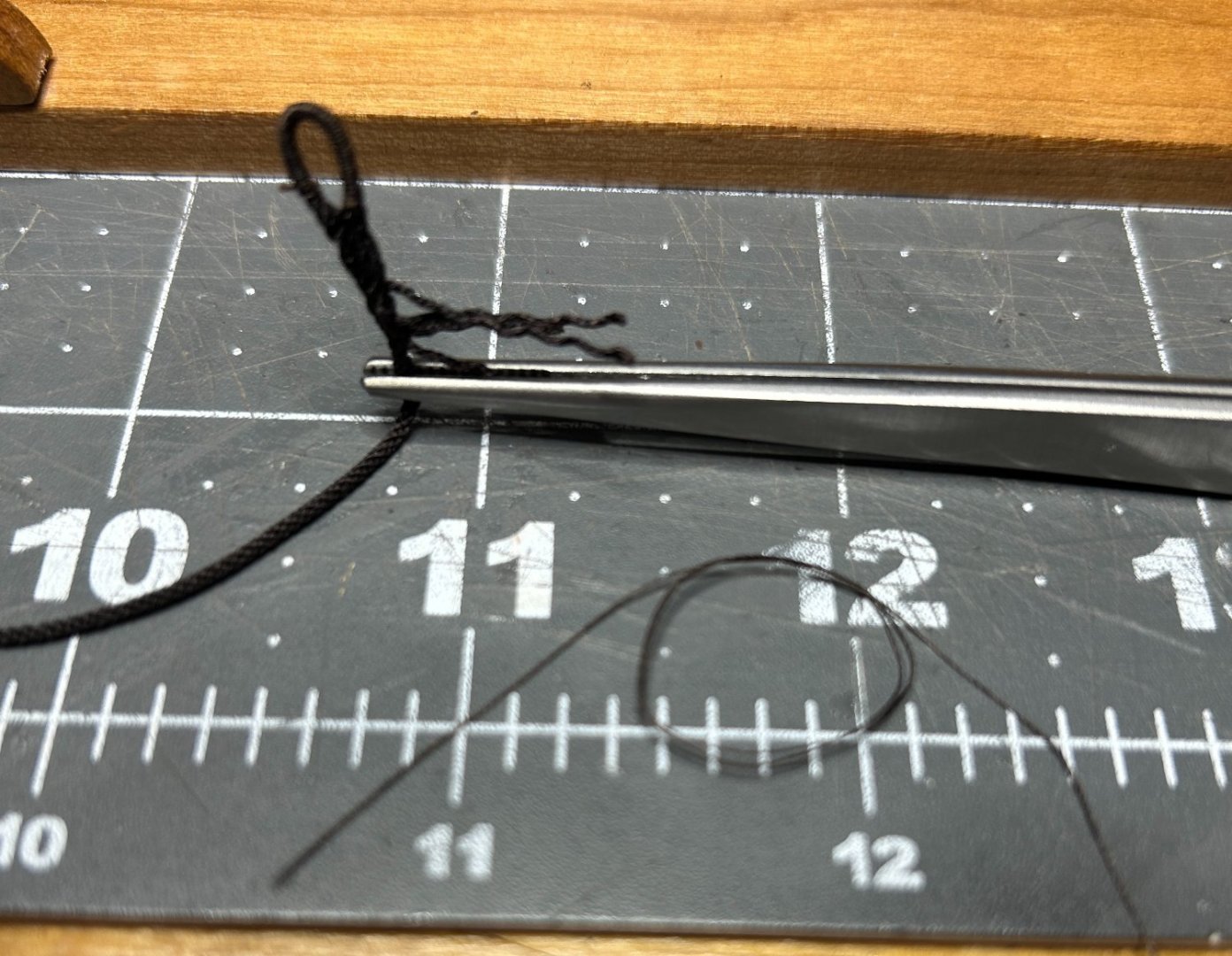
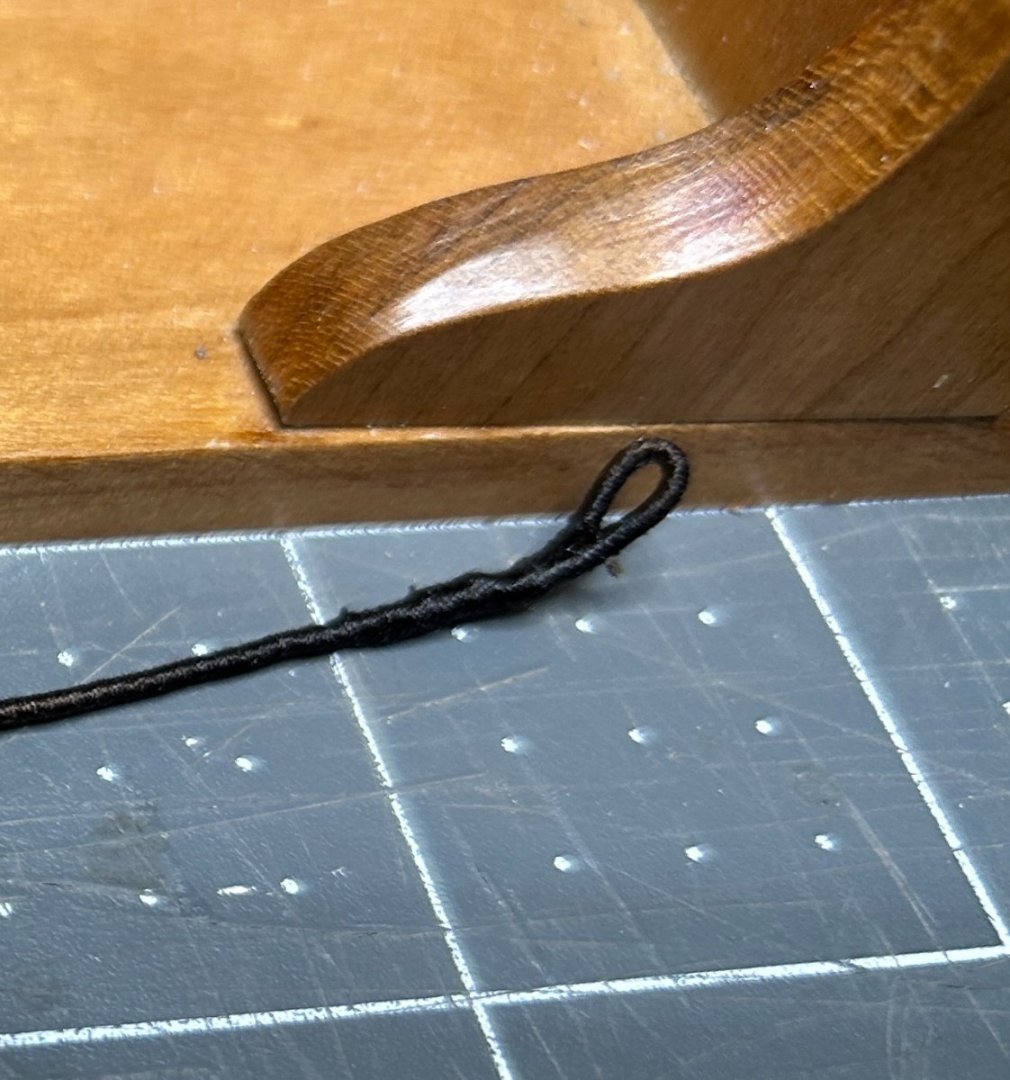
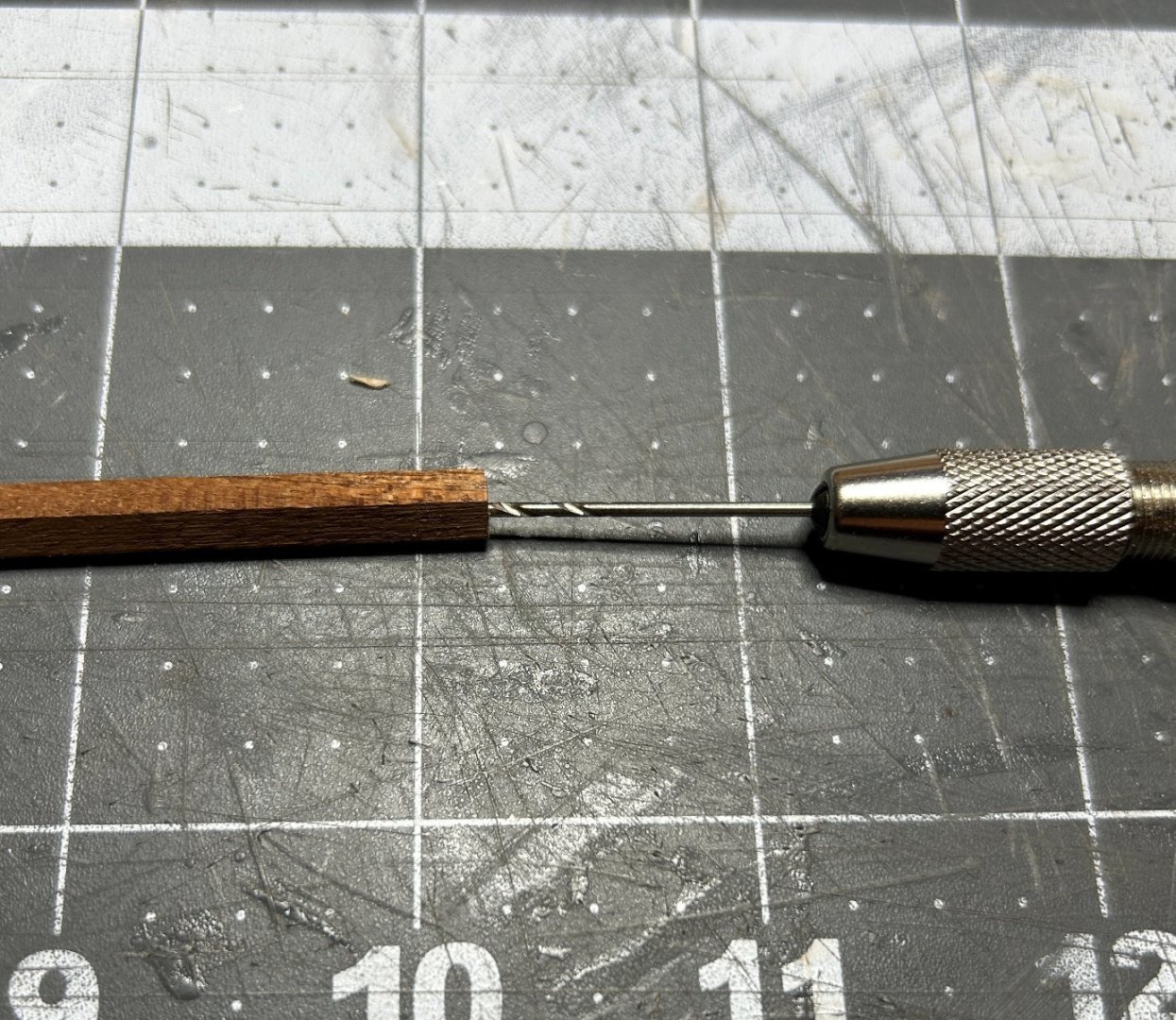
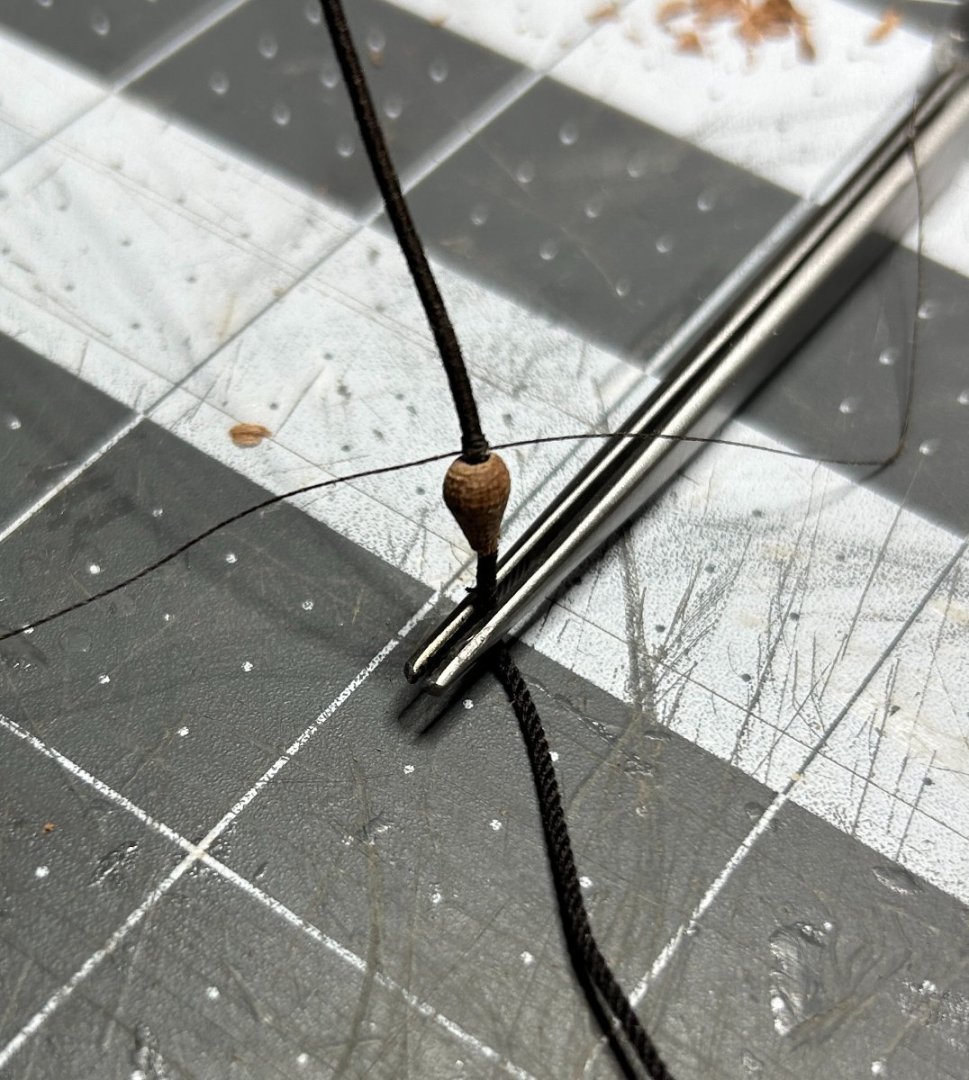
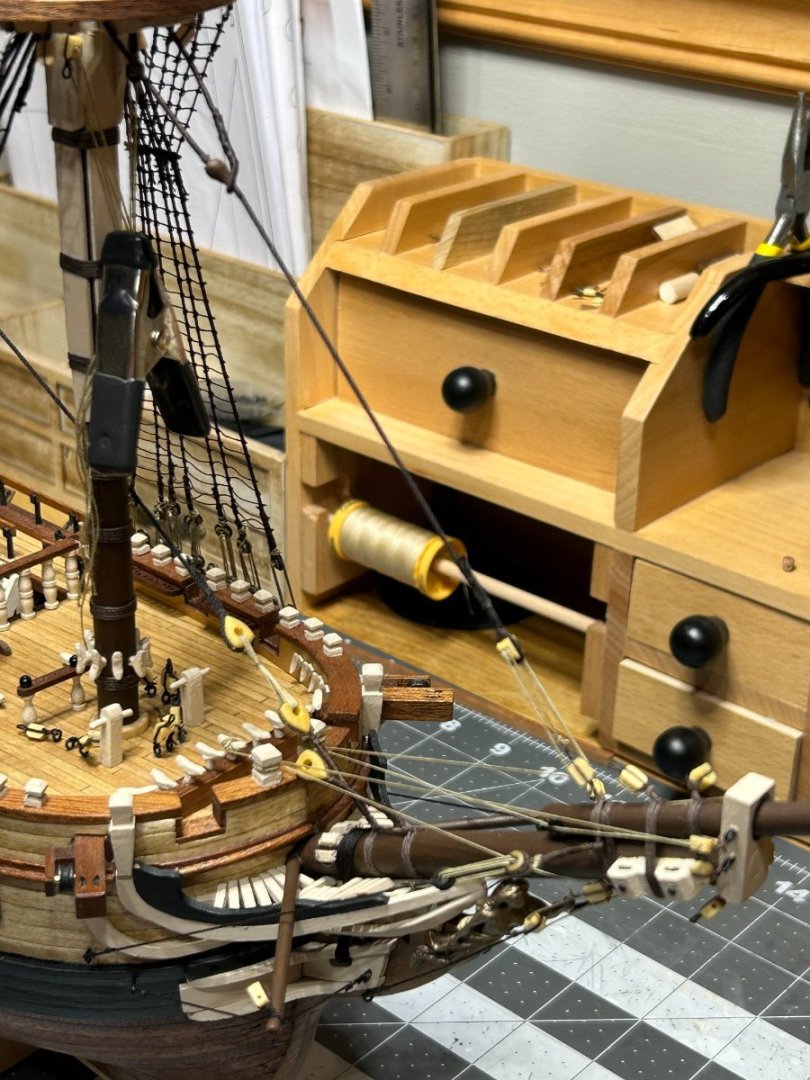
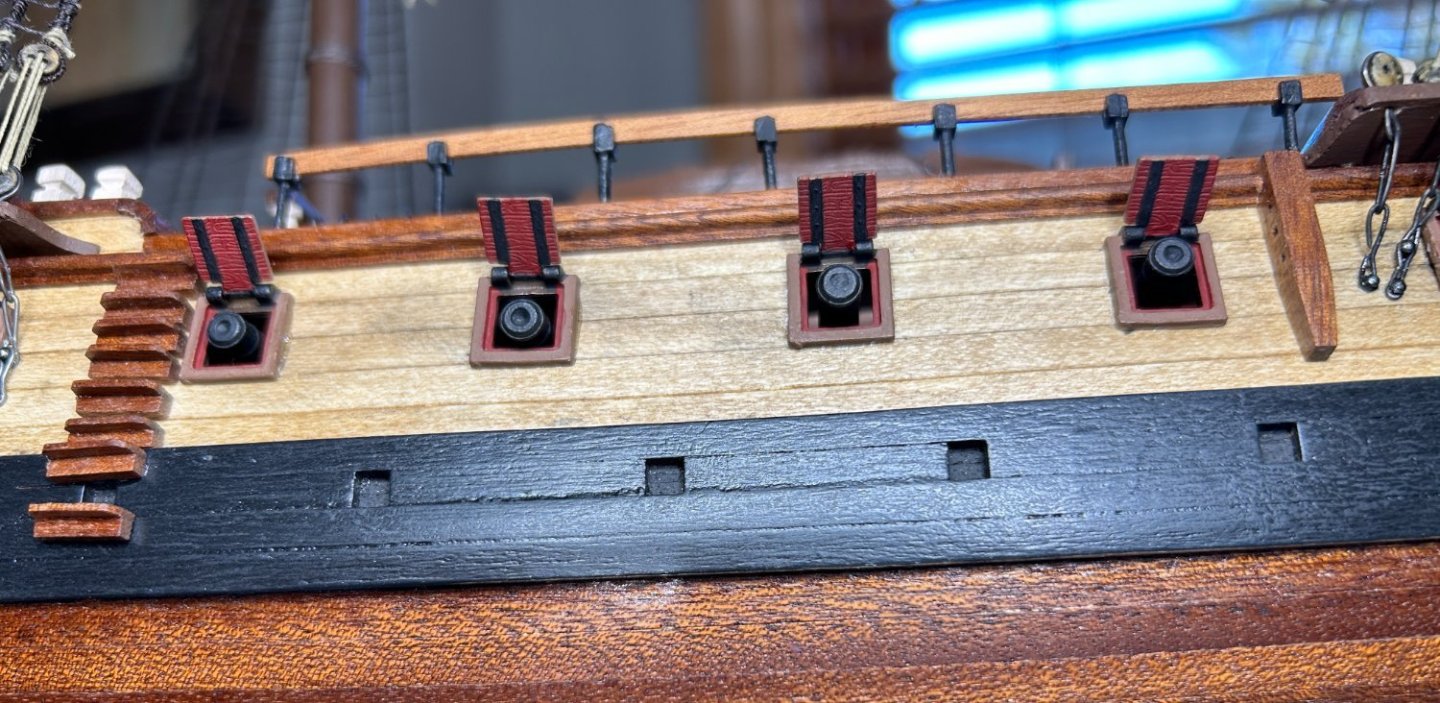
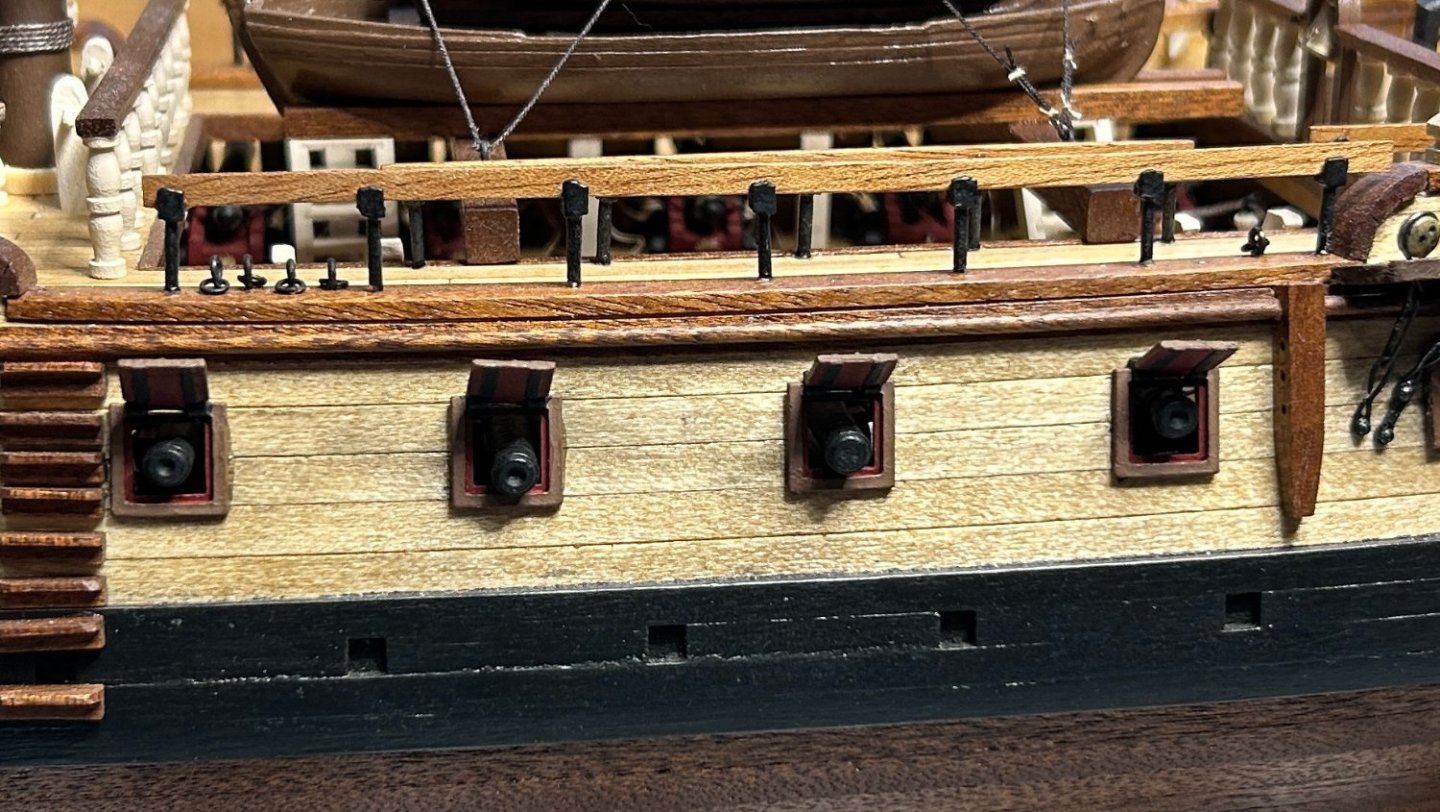
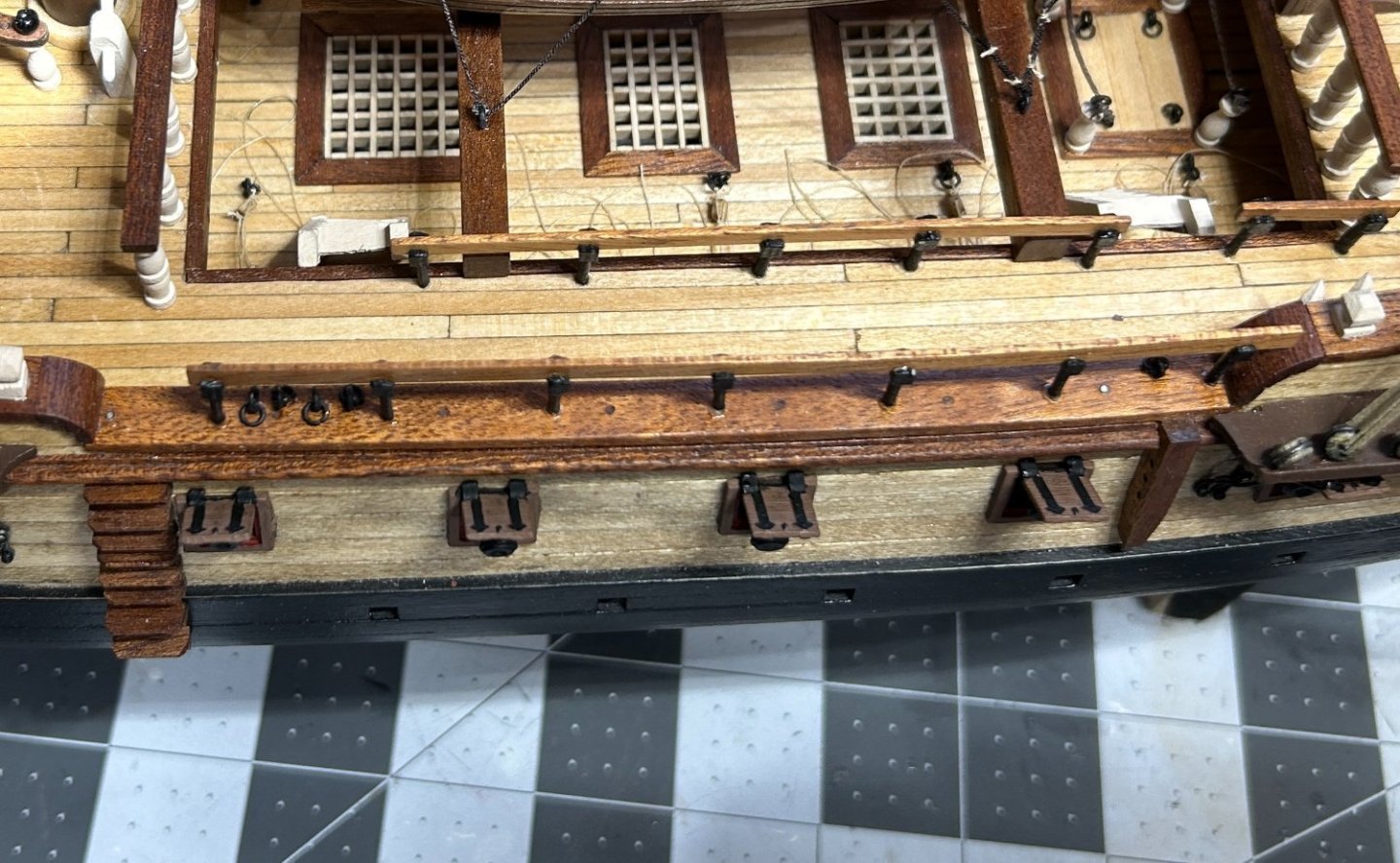

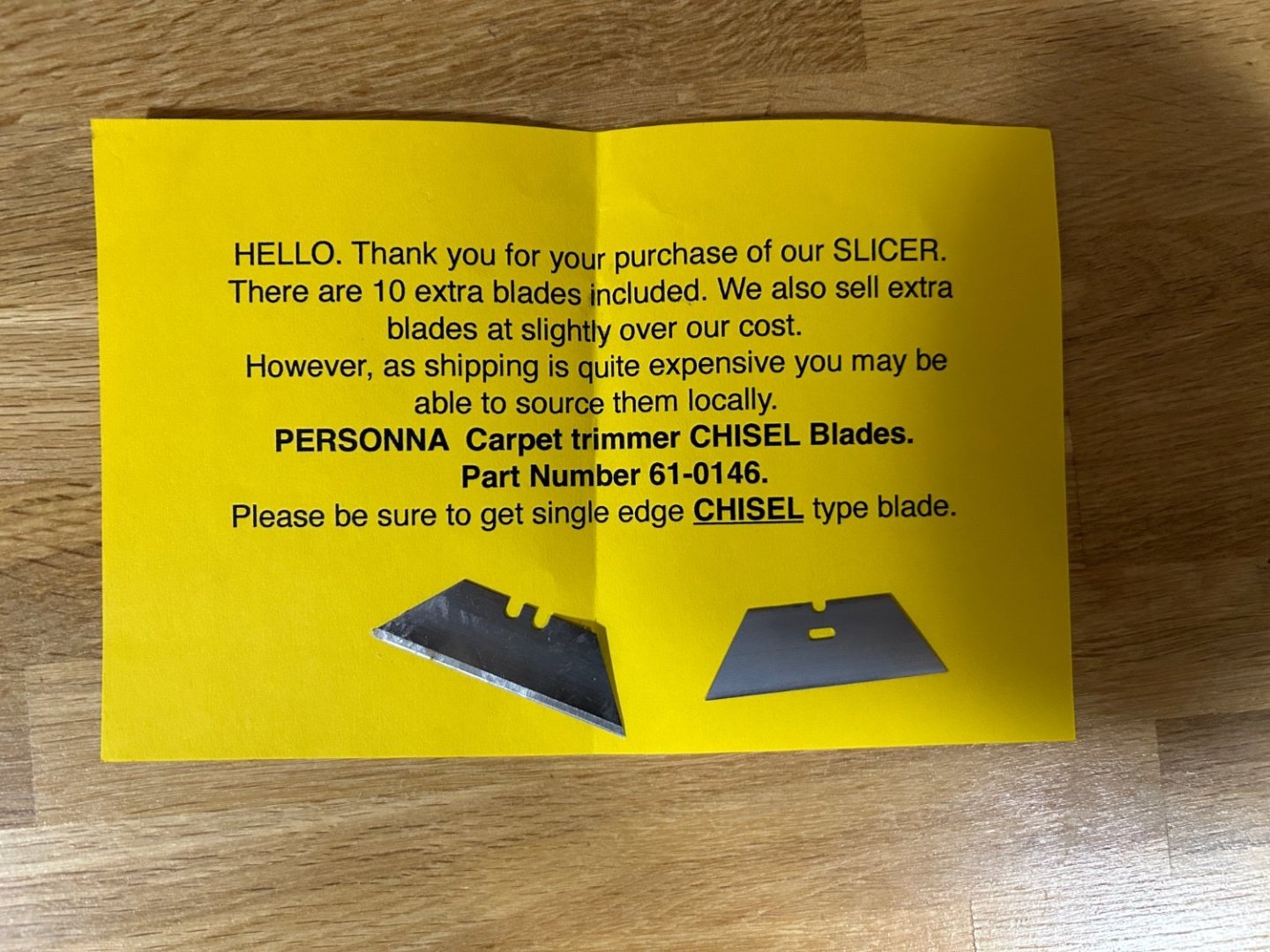
Masts and Bowsprit - Glue or Not?
in Masting, rigging and sails
Posted
I am fairly new to the hobby, so I can’t speak to longevity. On my first build I use PVA, but I don’t think I needed to. On my second build I didn’t use any glue. The bow sprit, foremast and main mast went in straight and are held there by the shrouds. The mizzen mast wanted to lean a little so I used some wedges to get it straight and then relied on the shrouds to keep it straight.